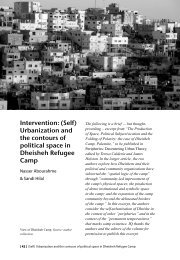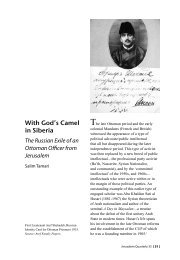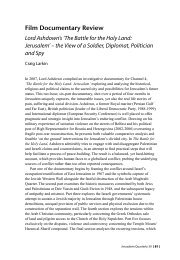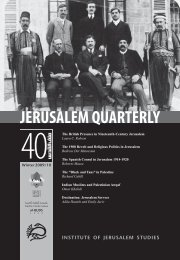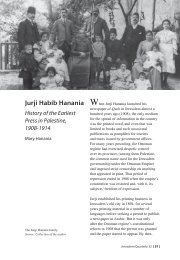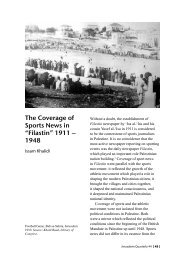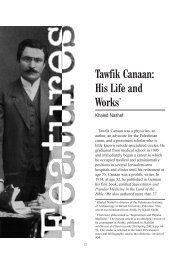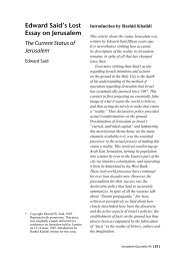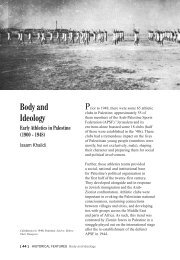PLUNDERING PALESTINE - Jerusalem Quarterly
PLUNDERING PALESTINE - Jerusalem Quarterly
PLUNDERING PALESTINE - Jerusalem Quarterly
Create successful ePaper yourself
Turn your PDF publications into a flip-book with our unique Google optimized e-Paper software.
This man excavated the village at the end of the 50s, he came three or five<br />
months, not the whole year, he would come in June or July and stay until<br />
October, and then he would disappear together with his group. In the winter,<br />
when the weather gets cold, the local people who worked with him would<br />
start digging, but not in daylight, just at night. The people of the village<br />
would object to that because diggers were destroying the land. But Pritchard<br />
would encourage those people and give them money for their finds. Later<br />
on those people started working for themselves. Pritchard was buying their<br />
finds through a middle man from the area of southern Hebron. This man<br />
would store all the finds in his home until Pritchard came back, and Pritchard<br />
would take all the objects and pay him any money he asks for, no questions<br />
asked. Other people were also selling him objects, and when he was not<br />
around they were selling them to souvenir shops in <strong>Jerusalem</strong>.<br />
Today’s archaeology is not about collecting objects but rather about collecting<br />
contextual data. Furthermore, this problem is not confined to the West Bank, but<br />
certainly spills over to Israel proper. As sites in the West Bank are being emptied,<br />
some Palestinian diggers are crossing the Green Line that separates Israel from the<br />
West Bank in search of more promising places to dig. In 2001, the Israel Antiquities<br />
Authority’s anti-theft unit caught a Palestinian Authority policeman digging within<br />
Israel. 8<br />
The Israeli Wall in the West Bank<br />
According to Palestinian Department of Antiquities estimates, the Wall that Israel is<br />
constructing in the West Bank will isolate more than 1,500 archaeological sites and<br />
features between the Green Line and the de facto western border of the Palestinian<br />
areas created by the Wall. A further 1,250 archaeological sites and features are<br />
threatened by the proposed Wall in the Jordan Valley. Thus, the Wall will potentially<br />
isolate a total of 2,800 archaeological sites and features between it and the Green<br />
Line – the internationally recognized border between Israel and Palestine (see table<br />
below). This is no small number, representing 23.3 percent of all archaeological sites<br />
in the Palestinian areas, and more than 12 percent of all known archaeological sites<br />
in historic Palestine. The Palestinian Department of Antiquities also says that the wall<br />
has destroyed partially or fully approximately 800 archaeological sites. This situation<br />
will undoubtedly have a disastrous impact on Palestine’s heritage and on tourism,<br />
because tourists come to this country mainly to enjoy its rich cultural heritage.<br />
<strong>Jerusalem</strong> <strong>Quarterly</strong> 33 [ 43 ]


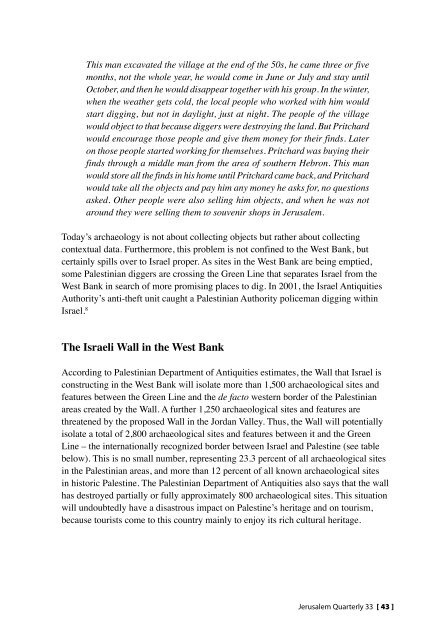
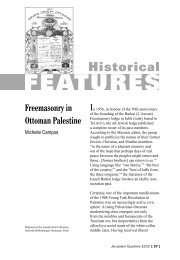
![In Search of Jerusalem Airport [pdf] - Jerusalem Quarterly](https://img.yumpu.com/49007736/1/180x260/in-search-of-jerusalem-airport-pdf-jerusalem-quarterly.jpg?quality=85)
